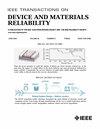集成三通道的非对称沟槽SiC MOSFET提高了性能和可靠性
IF 2.5
3区 工程技术
Q2 ENGINEERING, ELECTRICAL & ELECTRONIC
IEEE Transactions on Device and Materials Reliability
Pub Date : 2024-12-04
DOI:10.1109/TDMR.2024.3510782
引用次数: 0
摘要
提出了一种新型的集成三通道(ITC)非对称沟槽SiC MOSFET (ATMOS),显著提高了其性能和可靠性。ITC包括反向传导通道(Ch3)和双正向传导通道(Ch1和Ch2)。Ch3由自偏置MOSFET (SBM)构成,由于漏极诱导的势垒降低效应,形成了一个低势垒,与p-i-n体二极管相比,其导通电压更低。另一方面,Ch1和Ch2分别由侧沟槽MOSFET和附加底平面MOSFET构成。它缩短了场效应管区域的宽度,实现了较低的栅极氧化电场。由于漏极引起的阻挡降低引起的反向阻断漏电流(IBL)被抑制。此外,由于栅极和漏极之间的耦合面积减小,底平面MOSFET降低了栅极-漏极电荷(QGD)和开关损耗。最后,Ch1和Ch2在正向混合过程中提供双电子电流路径,显著降低器件的比导通电阻(Ron,sp)。仿真结果表明,所提出的ITC-ATMOS在50A时实现了本体二极管从2.8V到2.0V的降低。峰值电场${\mathrm {E}}_{\mathrm {max}}$降低至1.27MV,且由于高温阻塞特性,集成SBM (I ${_{\text {BL}}} {=} 10{^{-}7}$ A)产生的漏电流(IBL)远小于集成肖特基势垒二极管(I ${{\text {BL}}} {=} 10{^{-}5}$ A),从而大大提高了长期可靠性。此外,与传统ATMOS相比,${\ mathm {R}}_{\ mathm {on,sp}}$降低了28.57%,${\ mathm {Q}}_{\ mathm {GD}}$和开关损耗分别降低了20.60%和41.4%。本文章由计算机程序翻译,如有差异,请以英文原文为准。
Asymmetric Trench SiC MOSFET With Integrated Three Channels for Improved Performance and Reliability
A novel Asymmetric Trench SiC MOSFET (ATMOS) with Integrated Three Channels (ITC) is presented, which improves the performance and reliability significantly. The ITC includes the reverse conduction channel (Ch3) and double forward conduction channels (Ch1 and Ch2). The Ch3 is constituted by the Self-Biased MOSFET (SBM), forming a low barrier due to the drain-induced barrier lowering effect, which results in a lower turn on voltage compared with the p-i-n body diode. On the other hand, the Ch1 and Ch2 are constituted by the side trench MOSFET and additional bottom planar MOSFET, respectively. It shortens the width of the JFET region, and a lower gate oxide electric field is achieved. The reverse blocking leakage current (IBL) caused by the drain-induced barrier lowering is suppressed. Moreover, the bottom planar MOSFET reduces the gate-drain charge (QGD) and switching losses due to the reduced coupling area between the Gate and Drain. Finally, The Ch1 and Ch2 provide double electron current paths during forward concoction, which reduces the specific on-resistance (Ron,sp) of the device remarkably. The simulation results show that the proposed ITC-ATMOS achieves a reduction ${\mathrm { V}}_{\mathrm { cut-in}}$ of the body diode from 2.8V to 2.0V at 50A. The peak electric field ${\mathrm { E}}_{\mathrm { max}}$ is reduced to 1.27MV, and the leakage current(IBL) caused by the integrated SBM (I ${_{\text {BL}}} {=} 10{^{-}7 }$ A) is much smaller than integrated Schottky Barrier Diodes (SBD) (I ${_{\text {BL}}} {=} 10{^{-}5 }$ A) for blocking characteristics at high-temperature, thus long-term reliability is greatly enhanced. Moreover, a decrease in ${\mathrm { R}}_{\mathrm { on,sp}}$ of 28.57%, and reductions in ${\mathrm { Q}}_{\mathrm { GD}}$ and switching losses by 20.60% and 41.4% are achieved when compared with the Conventional ATMOS, respectively.
求助全文
通过发布文献求助,成功后即可免费获取论文全文。
去求助
来源期刊

IEEE Transactions on Device and Materials Reliability
工程技术-工程:电子与电气
CiteScore
4.80
自引率
5.00%
发文量
71
审稿时长
6-12 weeks
期刊介绍:
The scope of the publication includes, but is not limited to Reliability of: Devices, Materials, Processes, Interfaces, Integrated Microsystems (including MEMS & Sensors), Transistors, Technology (CMOS, BiCMOS, etc.), Integrated Circuits (IC, SSI, MSI, LSI, ULSI, ELSI, etc.), Thin Film Transistor Applications. The measurement and understanding of the reliability of such entities at each phase, from the concept stage through research and development and into manufacturing scale-up, provides the overall database on the reliability of the devices, materials, processes, package and other necessities for the successful introduction of a product to market. This reliability database is the foundation for a quality product, which meets customer expectation. A product so developed has high reliability. High quality will be achieved because product weaknesses will have been found (root cause analysis) and designed out of the final product. This process of ever increasing reliability and quality will result in a superior product. In the end, reliability and quality are not one thing; but in a sense everything, which can be or has to be done to guarantee that the product successfully performs in the field under customer conditions. Our goal is to capture these advances. An additional objective is to focus cross fertilized communication in the state of the art of reliability of electronic materials and devices and provide fundamental understanding of basic phenomena that affect reliability. In addition, the publication is a forum for interdisciplinary studies on reliability. An overall goal is to provide leading edge/state of the art information, which is critically relevant to the creation of reliable products.
 求助内容:
求助内容: 应助结果提醒方式:
应助结果提醒方式:


